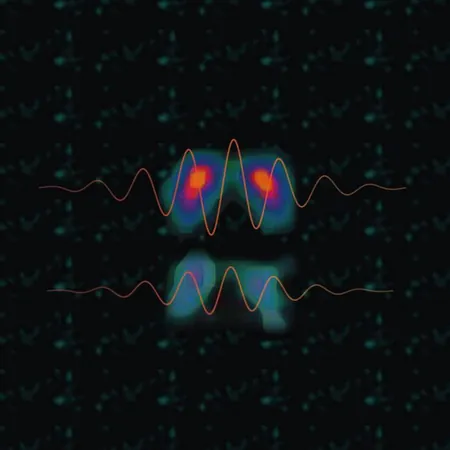
Shocking New Findings Reveal How Dopamine Affects Resting Tremor in Parkinson's Disease!
2024-11-18
Author: Mei
Introduction
Parkinson's Disease (PD) is a complex neurological disorder known for its distinctive motor symptoms—including tremor, rigidity, and slowed movements. Among these, resting tremor (RT) is perhaps the most iconic yet remains astonishingly enigmatic.
Groundbreaking Study Findings
A groundbreaking new study from the Champalimaud Foundation has shed light on the intricate relationship between resting tremor and dopamine (DA), the pivotal neurotransmitter responsible for regulating movement. Conducted by a team at the Neural Circuits Dysfunction Lab in collaboration with the Neuropsychiatry and Nuclear Medicine Labs, this significant research analyzed data from approximately 500 Parkinson's patients and revealed that higher dopamine levels in certain brain regions could contradict previously held assumptions about tremor symptoms.
Insights from Researchers
Dr. Marcelo Mendonça, one of the lead authors of the study, shared stunning insights: “We found that patients experiencing tremors actually have more dopamine preserved in the caudate nucleus—a region essential for motion planning and cognition. This challenges our traditional perspectives on dopamine loss and its correlation with PD symptoms.”
Implications of the Discovery
The implications of this discovery are enormous, encouraging a shift away from simplified PD classifications towards more nuanced, biology-informed approaches. Understanding the specific neural circuits involved in tremor could pave the way for customized therapeutic strategies that enhance the quality of life for those afflicted by the condition. “By clarifying the complexity of PD symptoms, we aspire to develop targeted interventions,” Mendonça added.
Published Research and Findings
Published in the journal *npj Parkinson’s Disease,* the study emphasizes that the loss of dopamine in areas like the putamen—integral for regulating movement—has always been viewed as a hallmark of PD. Yet the connection between dopamine depletion and RT exhibits a perplexing complexity. Some patients find significant relief from dopamine replacement therapies like L-DOPA, while others experience little to no improvement, along with a worsening of symptoms. This perplexing situation implies that the relationship between dopamine levels and RT is far from straightforward.
Research Methodology
Delving deeper, the researchers employed a wealth of data—clinical assessments, DaT scans revealing dopaminergic neuron status, and wearable motion sensors to accurately gauge tremor intensity. The prevailing belief suggested that diminished dopamine levels correlate with heightened symptom severity, yet this study uncovered a counterintuitive finding. Dr. Pedro C. Ferreira, co-first author, remarked, “Our findings indicate that increased dopamine activity in the caudate correlates with more severe tremors, completely flipping accepted wisdom on its head.”
Bizarre Correlation
Notably, the study established a bizarre correlation suggesting that greater dopamine preservation in the caudate on one side of the brain corresponds with intensified tremors on the same side of the body. “This was an unexpected finding,” commented Dr. Joaquim Alves da Silva, head of the Neural Circuits Dysfunction Lab, “Typically, each hemisphere governs movement on the opposite side of the body.”
Building on Previous Research
This new research builds upon earlier work by the same team, challenging conventional wisdom that merges various symptoms under one umbrella. Their previous findings indicated that rest tremor differs based on the progression type of PD: patients exhibiting “brain-first” pathology tend to have more resistant tremors compared to those with a “gut-first” approach, where the disease manifests differently.
Future Directions
As the study progresses, the authors emphasize that the relationship between dopamine levels and symptomatic expression in PD is not uniform; various patients may lose dopamine in different neural pathways. However, they remain determined to establish causality by investigating these phenomena in animal models, thereby manipulating specific cells to analyze tremor impacts.
Conclusion
As urgency surrounding personalized treatment for PD grows, these revelations provide crucial insights not only for patients and caregivers but could also signal a major shift in how the medical community approaches tremor management in Parkinson’s Disease. The adventure in unlocking the mysteries of dopamine and Parkinson's continues!

 Brasil (PT)
Brasil (PT)
 Canada (EN)
Canada (EN)
 Chile (ES)
Chile (ES)
 España (ES)
España (ES)
 France (FR)
France (FR)
 Hong Kong (EN)
Hong Kong (EN)
 Italia (IT)
Italia (IT)
 日本 (JA)
日本 (JA)
 Magyarország (HU)
Magyarország (HU)
 Norge (NO)
Norge (NO)
 Polska (PL)
Polska (PL)
 Schweiz (DE)
Schweiz (DE)
 Singapore (EN)
Singapore (EN)
 Sverige (SV)
Sverige (SV)
 Suomi (FI)
Suomi (FI)
 Türkiye (TR)
Türkiye (TR)